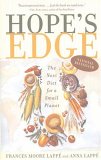Summary | Excerpt | Reviews | Readalikes | Genres & Themes | Author Bio

Critics' Opinion:
Readers' Opinion:
First Published:
Jan 2002, 400 pages
Paperback:
Apr 2003, 400 pages
But what if they don't and aren't?
Fromm argues that it's quite possible for there to be a mismatch; for our ideas to do us in. I had double-underlined a quote in The Anatomy of Human Destructiveness that I have pondered for years: "It is man's humanity that makes him so inhumane."17 But inhumane means "not human." How can we do what's not human? The answer, for Fromm, is the power of our minds to invent ideas that snuff out our deepest sensibilities, even our common sense. We create a world that doesn't feel like ours because these big ideas can overpower our innate sense of connection to one another and cause us to suppress our need for power in the best sense of the word-power to express ourselves in the public world.
Over the years, it's become ironic to me that we view ourselves as thinkers. We think-that's what distinguishes human beings, right? We see ourselves stuck in Rodin's pose. But no, I've come to see that we're not only thinkers; we're also absorbers. We mold our perceptions of reality, and of ourselves, to conform to ideas we hold, ideas we often absorb without thinking. And we're adapters: We seek desperately to shape ourselves according to these ideas of who we are and what we believe others expect from us.
So there it is. We can only see that which fits into our "map"-what we expect to see-and mostly we can't even see the map. Yet we adapt ourselves daily to it. Quite a challenge! At the University of Montana gathering, I reflected on these ideas with students over a sumptuous organic lunch. I remember one whose eyes lit up, "Yes! It's like gazing through a screen; if you look long enough you don't see the screen at all."
We have gazed so long through the particular screen creating this world that we simply do not see it.
To begin to break free of life-destroying patterns, to create a world aligned with our truer selves in which no one goes hungry or is made sick from the food they eat, Anna and I believe we have to, and we can, gain new eyes. The challenge is enormous, but we can come to see the map shaping and limiting our vision.
So what are the big ideas of today's dominant mental map?
Anna and I have condensed them into the five that seem most potent to us-those that not only lock us into seeing scarcity in a world of plenty but that shape even our understanding of what it means to be human. They tell us where to look for solutions to the worsening global crises and ultimately influence what would seem to be the most individual choice of all: how we seek meaning in our lives.
Thought Trap One: The enemy is scarcity, production is our savior. In the original Diet for a Small Planet, I set out to explode the scarcity myth with mountains of evidence showing the abundance-and the waste-in our food system.
For me, discovering that here in the U.S. we feed sixteen pounds of grain and soy to cattle to get one pound back in meat was the first real wake-up call. Because so much of our harvested acreage goes to feed livestock, the waste is staggering. I calculated that the grain we annually feed to livestock could provide the equivalent of a bowl of food for every person on earth every day of the year! So, I thought, anyone who simply looked at the facts would be spurred to make big changes.
But I guess I didn't appreciate the strength of this thought trap's grip. Even now, thirty years later, the U.S. Department of Agriculture sees no problem at all. Its economists maintain that the grain-to-beef ratio is "only" seven to one-as if seven pounds fed to get only one pound back is some mark of efficiency. (To get their seven-to-one ratio, government analysts must credit grain and soy feeding with all the meat produced, although they know that more than half comes from grass, hay, and other things cattle eat.)





The House on Biscayne Bay
by Chanel Cleeton
As death stalks a gothic mansion in Miami, the lives of two women intertwine as the past and present collide.

The Flower Sisters
by Michelle Collins Anderson
From the new Fannie Flagg of the Ozarks, a richly-woven story of family, forgiveness, and reinvention.

The Funeral Cryer by Wenyan Lu
Debut novelist Wenyan Lu brings us this witty yet profound story about one woman's midlife reawakening in contemporary rural China.
Your guide toexceptional books
BookBrowse seeks out and recommends the best in contemporary fiction and nonfiction—books that not only engage and entertain but also deepen our understanding of ourselves and the world around us.